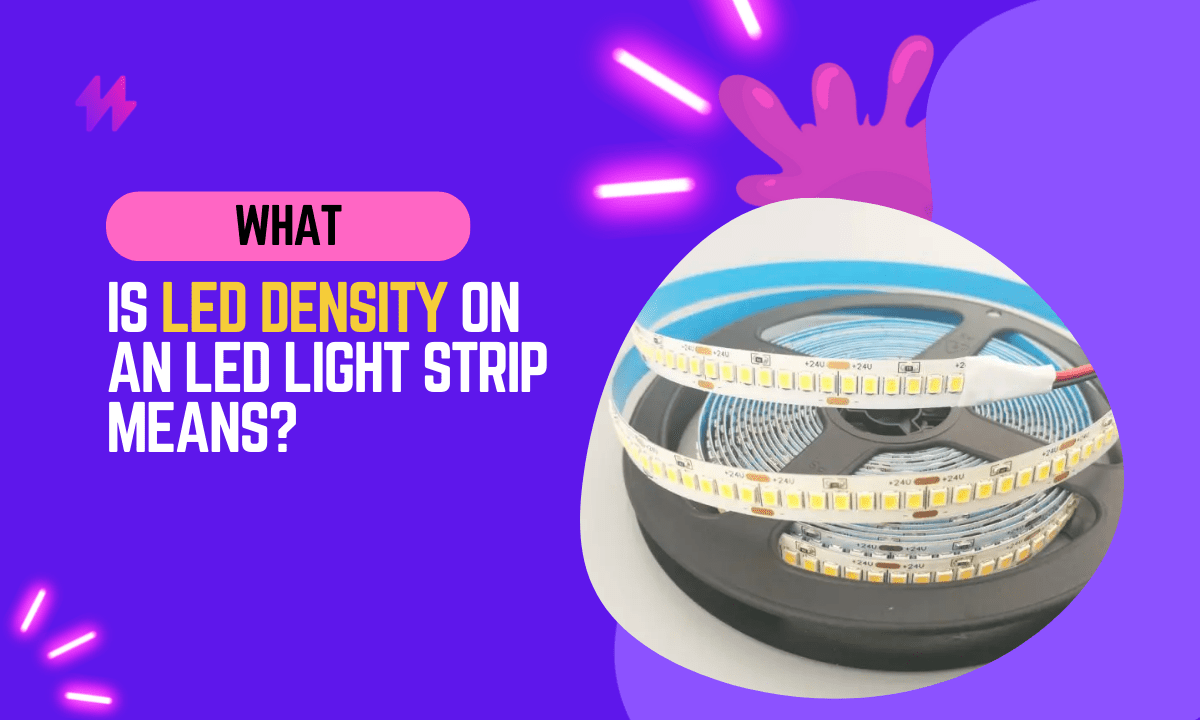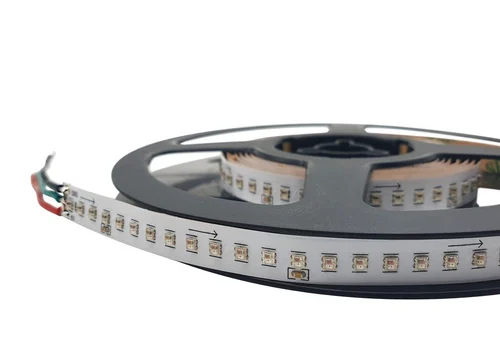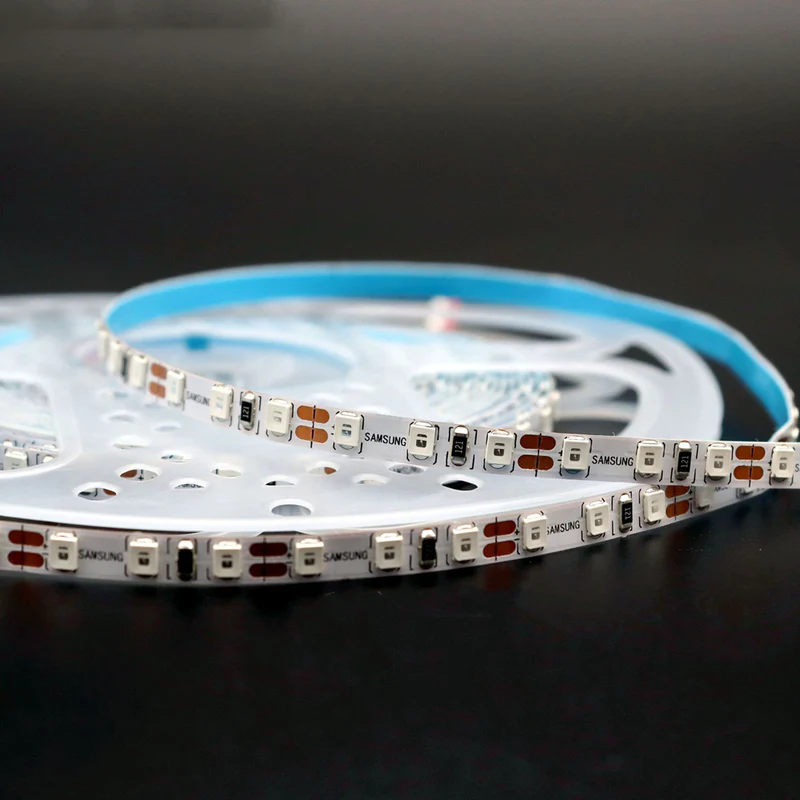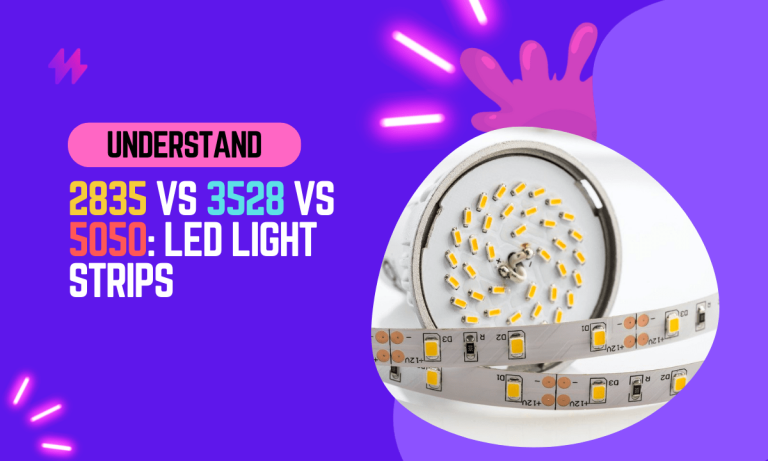What Does LED Density on an LED Strip Mean?

Have you ever wondered what LED density on an LED strip means? Maybe your TV won’t turn on, or your Christmas lights are flickering. If so, you’re not alone. LED density is a common problem that can cause all sorts of issues.
In this article, I’ll explain what LED density is and how it can affect your lights. I’ll also share some tips on how to troubleshoot LED density problems. So if you’re having trouble with your LED lights, read on!
By the end of this article, you’ll better understand LED density and how to fix it. So if you’re ready to learn more, let’s get started!
Understanding LED density is crucial for lighting projects, especially when choosing between types of led strip lights. Proper LED density not only dictates the brightness of the light strip but also affects its overall light color and distribution, ensuring a seamless lighting appearance in various settings.
Understanding LED Density in Your LED Strip Light: Key Insights and Considerations
LED density is a measure of the number of LEDs per unit length of an LED strip. It is typically expressed in LEDs per meter (LEDs/m). The higher the LED density, the more LEDs there are per unit length, and the brighter the strip will be.
LED density is an important factor to consider when choosing an LED strip for your project. If you need a bright, uniform light, then you will want to choose an LED strip with a high LED density. However, if you are working with a tight budget, you may want to choose an LED strip with a lower LED density.
LED density is also affected by the size of the LEDs. Smaller LEDs can be packed closer together than larger LEDs, so an LED strip with small LEDs can have a higher LED density than an LED strip with large LEDs.
In addition to the number of LEDs per unit length, LED density also refers to the distribution of the LEDs along the strip. Some LED strips have LEDs evenly spaced along the strip, while others have LEDs clustered together in certain areas. The distribution of the LEDs can affect the overall appearance of the light.
Also read: RGBWW vs RGBW Strip Lights: Which Is Right for You?
When selecting the right LED strip lights for your project, it’s essential to understand the implications of LED density. Higher density strips are often favored for applications like theatrical lighting and accent lighting due to their ability to create a more uniform and brighter light output, making them ideal for various lighting installations. With the right LED density, you can optimize your lighting setup to achieve the desired brightness levels and light distribution, ensuring a professional finish. Understanding how many LEDs are attached to a circuit board will also help in determining the overall lighting quality and the suitability of different strip light types for your needs.
Understanding What LED Density on an LED Strip Means: How to Calculate It

The formula for calculating LED density is:
“`
LED density (LEDs/m) = Number of LEDs / Length of strip (m)
“`
For example, if an LED strip has 100 LEDs and is 1 meter long, then the LED density is 100 LEDs / 1 m = 100 LEDs/m.
When selecting LED strip lights, it’s important to consider the distance between the individual LEDs, as LED density can significantly influence light quality and brightness. Higher-density strips will often feature a greater number of LEDs per length, which can enhance their overall output, making them preferable for applications requiring bright and uniform lighting, such as in bar lighting or commercial displays.
Understanding What LED Density on an LED Strip Means: Factors and Considerations
Several factors can affect LED density, including:
- The size of the LEDs: Smaller LEDs can be packed closer together than larger LEDs, so an LED strip with small LEDs can have a higher LED density than an LED strip with large LEDs.
- The spacing of the LEDs: Some LED strips have LEDs evenly spaced along the strip, while others have LEDs clustered together in certain areas. The distribution of the LEDs can affect the overall appearance of the light.
- The type of LED strip: There are two main types: flexible LED strips and rigid LED strips. Flexible LED strips are more flexible than rigid LED strips, but they typically have a lower LED density. Rigid LED strips are less flexible than flexible LED strips, but they typically have a higher LED density.
Also read: 2835 vs 3528 vs 5050: Understanding LED Light Strip
When working with LED strip lights, understanding the variations in LED density is essential to achieve the desired light output and aesthetic. Additionally, employing high-density strips can lead to enhanced brightness and color distribution, which is particularly advantageous for projects requiring vibrant and uniform illumination, such as in retail displays or indoor accent lighting. Choosing the right LED strip density not only maximizes the effectiveness of your artificial light source but also plays a significant role in the overall light quality and visual appeal of your lighting design. It’s critical to assess your project requirements and select between high-density and standard density options to ensure optimal performance and energy efficiency.
Understanding What LED Density on an LED Strip Means for Choosing the Right Option for Your Project

The right LED density for your project will depend on some factors, including:
The right LED density for your project will depend on some factors, including the type of application, the desired light appearance, and energy efficiency requirements. Understanding what does LED density on an LED strip mean, as well as the differences between high-density strips and standard-density strips, will ultimately guide you in selecting the best LED options for your lighting needs. Additionally, factors such as LEDs/m strip and voltage drop should be carefully considered to ensure optimal performance and brightness throughout your lighting system.
- Brightness of the light: The higher the LED density, the brighter the light will be.
- Size of the project: The larger the project, the more LEDs you will need.
- Budget: The higher the LED density, the more expensive the LED strip will be.
Understanding What LED Density on an LED Strip Means: FAQs
Understanding What LED Density on an LED Strip Means: Differences Between High and Low LED Density Strips
High LED density strips have more LEDs per meter than low LED density strips. This means that they are brighter and produce a more uniform light. However, they are also more expensive than low LED-density strips.
When it comes to selecting the right LED strip lights for different projects, the distinctions between high-density and low-density strips are significant. High-density strips, which typically feature 18-36 LEDs per length, create powerful lights ideal for applications that demand bright, even illumination, while low-density strips can be more economical but may not deliver the same brightness or quality in lighting design. Understanding that **led density is important in determining the distance between LEDs** will guide you in tailoring your **led strip project** to achieve the desired effect and brightness.
Understanding What LED Density on an LED Strip Means: Benefits of High LED Density Strips
High LED density strips offer a number of benefits over low LED density strips, including:
High LED density strips offer a number of benefits over low LED density strips, including enhanced brightness and improved color uniformity, making them a preferred choice for applications that require vivid illumination. Choosing the **best-led options** with **high-density strips** can significantly elevate the overall effectiveness of your **led system**, ensuring that your lighting projects achieve the highest quality and visual appeal.
- Brightness: High LED density strips are brighter than low LED density strips. This makes them ideal for applications where brightness is important, such as under cabinet lighting and accent lighting.
- Uniformity: High LED density strips produce a more uniform light than low LED density strips. This means that there is less variation in brightness from one end of the strip to the other.
- Cost-effectiveness: High LED density strips are more cost-effective than low LED density strips. This is because they use fewer LEDs to achieve the same level of brightness.
Understanding What LED Density on an LED Strip Means: Drawbacks of High LED Density Strips
The main drawback of using a high LED density strip is the cost. High LED density strips are more expensive than low LED density strips. This is because they use more LEDs to achieve the same level of brightness.
While high-density LED strips provide superior brightness, they do come with a higher price tag, which can affect budget considerations for lighting projects. However, the investment in high-density strips can often lead to energy efficiency and enhanced light quality over time, making them a smart choice for long-term lighting solutions, especially for applications requiring vibrant colors and consistent illumination like **rgb lighting** or **grow lights**.
What Does LED Density on an LED Strip Mean: Factors to Consider When Choosing an LED Strip
When choosing an LED strip, there are some factors you should consider, including:
- LED density: The LED density of the strip will determine how bright the strip is.
- Power rating: The power rating of the strip will determine how much power it consumes.
- Type of lens: The type of lens used on the strip will affect the distribution of light.
- Price: The price of the strip will vary depending on the LED density, power rating, and lens type.
By considering these factors, you can choose an LED strip that meets your needs and budget.
When evaluating LED strip lights, it’s essential to consider the impact of **led density differences** on your overall lighting experience. Additionally, selecting **quality LEDs** in high-density strip lights can significantly enhance the brightness and uniformity of your lighting projects, making them ideal for both aesthetic and practical uses.
Final Thoughts on Understanding LED Density in Your Projects: A Comprehensive Overview
In conclusion, the concept of LED density in LED strip lighting is critical for users to understand as it significantly impacts both the aesthetic and functional aspects of lighting. LED density, defined as the number of LEDs per meter or foot, determines the brightness and consistency of the light emitted from the strip. Higher densities generally result in brighter and more uniformly distributed light, which is essential for tasks requiring precision and clarity, such as under cabinet lighting in kitchens or workspace illumination. Conversely, lower densities might be suitable for ambient lighting or decorative purposes where a softer light is preferable. The choice of LED density should align with the specific lighting needs of the area to be illuminated, balancing between energy consumption, brightness requirements, and the desired visual effect.
Moreover, it’s important for consumers to consider the implications of higher LED densities beyond just improved light output. Higher densities can lead to increased power consumption and heat generation, necessitating careful consideration of heat management and power supply solutions. Efficient heat dissipation is vital to preserve the lifespan of the LEDs, as excessive heat can degrade the diodes over time and reduce their operational efficiency. Furthermore, when planning the installation of high-density LED strips, one must ensure that the power supply is adequately rated to handle the increased load. By comprehensively understanding LED density and its effects on lighting performance and system requirements, users can make informed decisions that enhance both the environment and the longevity of their LED lighting solutions.
What Does LED Density On An LED Strip Mean | Exploring LED Density in Greater Detail
Understanding what LED density on an LED strip means is crucial for selecting the right lighting solution. LED density refers to the number of LEDs per length, often measured in leds/length. Higher density strips typically feature several LEDs closely spaced, resulting in increased brightness and a more uniform light output. For instance, high-density strips with high-power LEDs can emit a vibrant white light, making them ideal for applications such as general illumination, display case lighting, or bias lighting. Conversely, lower-density strips may be suitable for decorative purposes where softer lighting is desired. Specific applications, such as horticulture lighting or vehicle lighting, may require particular LED types like RGB or nichia LEDs to achieve desired effects. Understanding these variables allows for informed decisions on LED strip products that fit specific needs while recognizing that LED density is not the only factor influencing brightness and light quality.
What Does LED Density on an LED Strip Mean | Definition and Explanation of LED Density
LED density refers to the number of LEDs mounted per unit length on an LED strip, which significantly influences the overall brightness and quality of light emitted. Standard density strips typically feature fewer SMD LEDs per meter, while high-density strips contain a greater quantity of LED emitters, resulting in a more luminous output. For those seeking bright lighting solutions, understanding what LED density on an LED strip means is crucial. Strips with a higher density of LED chips will appear brighter than their lower-density counterparts. This consideration is essential for applications such as residential lighting, where total brightness and light direction can dramatically impact the atmosphere.
Different density options also affect the visual impact of the light source. High-density strips produce a more uniform illumination, ideal for tasks that require consistent lighting, such as shelf lighting or indoor strip lights. On the other hand, low output LEDs may serve specific purposes, such as accent lighting or decorative displays. Dimmer compatibility also varies with LED density; high-density strips may require specific dimming capabilities for smooth light adjustments. Understanding the intricacies of LED technology, including how wattage, light outputs, and color temperature interplay, is vital for selecting the most suitable light strip products for any project.
Visual Impact of Different LED Densities
LED density on a strip has a significant influence on the visual impact of the light emitted. High density refers to a greater number of LEDs packed closely together, resulting in a brighter and more uniform light. This is particularly noticeable in applications requiring strong illumination, such as outdoor lighting or general lighting purposes. For instance, a high brightness strip can outshine standard-density strip light, making it ideal for environments needing vibrant color-changing lighting or white lighting options. The overall effect can also vary, depending on the diffusion properties of the cover used. A diffuser can soften the light, providing a more even distribution while reducing harsh shadows, which can enhance the visual appeal.
Different LED densities create distinct lighting aesthetics and functional benefits. Low-profile LEDs can be used effectively in residential lighting applications, offering adjustable brightness settings for situations like light shows or romantic dinners. Conversely, high-density strips can achieve impressive brightness with less power consumption, making them suitable for horticulture-specific LEDs. While LED density is crucial, it is not the only factor in determining brightness and light quality. Light strip categories vary significantly, and careful selection of strip light products can lead to optimal results. Understanding what does LED density on an LED strip mean helps in selecting the appropriate light strip options for various applications, ensuring that users achieve their desired visual effects.
Calculating LED Density for Your Needs
Understanding how to calculate LED density for your projects is essential for achieving optimal lighting results. LED density refers to the number of LEDs mounted per unit length on an LED strip, which significantly affects the brightness and light quality. For example, high-density strips, such as those with luxeon LEDs, provide a more intense light output compared to lower-density options. It’s important to recognize that while LED density is critical, it is not the only factor influencing brightness; factors like strip light power, type of LEDs used, and the overall length of the light strip also play vital roles. Considerations such as the intended use, whether for decorative purposes with multi-colored LEDs or functional lighting with high CRI strip lights, will guide your decision. Remember, variations in strip light installations or configurations, including the choice between rigid strip lighting or flexible strip lights, can impact the final look and performance of your lighting system.
StepbyStep Guide to LED Density Calculation
Calculating LED density involves understanding various parameters that contribute to the overall effectiveness of light strips. Knowing what LED density on an LED strip means is essential for selecting the right product for your project. To start, identify the type of LED strip you want, such as high-power surface or COB strip lights, and note the number of LEDs per segment. This information helps in determining the potential brightness and light quality emitted by the LED strip. High-density strips often have a greater number of bulbs per foot, which can result in a more uniform light distribution, making them ideal for permanent lighting installations.
Next, consider the power consumption of the LED strip. Understanding the strip light wires, LED strip voltage, and the wattage required will guide you in selecting the appropriate light fixture and dimmer options. Low-voltage dimmers are commonly used with LED strips, including the 0-10V wall dimmer and phase-cut wall-dimmer, which can enhance the controllability of brightness. Keep in mind that LED density is not the only factor in determining brightness; the actual light output and color temperature also play critical roles. Always consult with LED experts or refer to resources like the tunable lighting guide to ensure optimal results for your specific needs.
Common Mistakes in LED Density Calculation
Calculating LED density incorrectly can lead to subpar lighting performance. Many enthusiasts underestimate how important it is to account for the specific application when determining the right LED density. For instance, using a blue LED in a low voltage lighting setup may seem ideal, but if the chosen LED strip segments do not match the intended visual spectrum, the results can be disappointing. While high-density strips may emit the brightest strip lights, LED density is not the only factor in determining brightness and light quality. Incorporating a diffuser cover can enhance visual appeal, but improper calculations may lead to overestimating the light output, leading to mismatched expectations.
Common errors often arise from neglecting the compatibility of LED strip power consumption with existing infrastructure. This includes the importance of understanding line voltage and how it relates to the overall system. High power surface applications, such as fluorescent or incandescent bulbs, require careful calculation of strip brightness to ensure safe operation. Using pre-manufactured options like RGB strip light or high-CRI strip lights without recognizing their unique characteristics can result in ineffective illumination. Always consider how strip light color and light density affect the diffusion and quality of the artificial light source, especially in spaces with reflective surfaces where light needs to be directed effectively.
Factors Influencing LED Density Selection
Different project types significantly influence the choice of LED density for optimal lighting solutions. Understanding what LED density on an LED strip means is crucial for effective planning. High-density strips often provide more intense light output, making them suitable for areas requiring substantial illumination. For example, a tight configuration of omni-directional LEDs can enhance the visible spectrum, while spaces needing a softer glow may benefit from lower density options like tape lights or ribbon lights. The wattage of the chosen LEDs means careful consideration for power consumption; high density strips may require more watts but can also offer similar brightness to lower density options while enhancing the overall strip light longevity. Projects with specific brightness specifications will dictate whether to opt for multicolor strip light installations or simple white LEDs. The mounting of LEDs, whether using wire leads or integrated PCB strip lights, should also align with the desired light direction, such as light upwards for mood enhancement or wall-switch dimmer control for convenience. Each choice plays a role in achieving the desired aesthetic and functional results in your lighting design.
Project Type and Its Influence on LED Density
Different projects require varying levels of brightness and light distribution, which significantly influences the choice of LED density. For instance, a decorative rope light installation may benefit from high-density LED strips that emit vibrant color RGB lights, providing a dazzling visual display. In contrast, a task-oriented light strip roll may prioritize even diffusion purposes over brightness, necessitating a lower density. Understanding what LED density on an LED strip means can help in selecting the appropriate configuration for specific applications.
Certain project types, such as stage lighting or accent lighting, often call for high-density options. These projects require strips that power bright illumination, making higher counts of mounted LEDs essential for achieving the desired effect. Vendors like Hitlights and Ledsupply offer a range of products catering to various density needs. Selecting the right high-density LED strip involves considering how the strip emits light and the effects desired in the space, especially when using a low voltage dimmer for customized control.
Environmental Considerations for LED Density
Selecting the appropriate LED density involves understanding various environmental factors. For instance, extreme temperatures can affect the performance and longevity of the LEDs. High-density LED strips may produce more heat due to their increased power consumption, which could necessitate special mounting solutions or heat dissipating mechanisms. Knowing what does LED density on an LED strip mean in terms of your specific environment can help you make informed decisions during the LED strip manufacturing process.
Humidity and moisture levels also play a crucial role in determining the suitable LED density for specific applications. Environments with high humidity require LEDs that can withstand moisture to ensure long-lasting performance. Using a high-density LED rope light in such settings can enhance brightness while also being mindful of the potential for condensation. Understanding what does LED density on an LED strip mean in relation to environmental conditions is essential for achieving optimal performance and durability.






